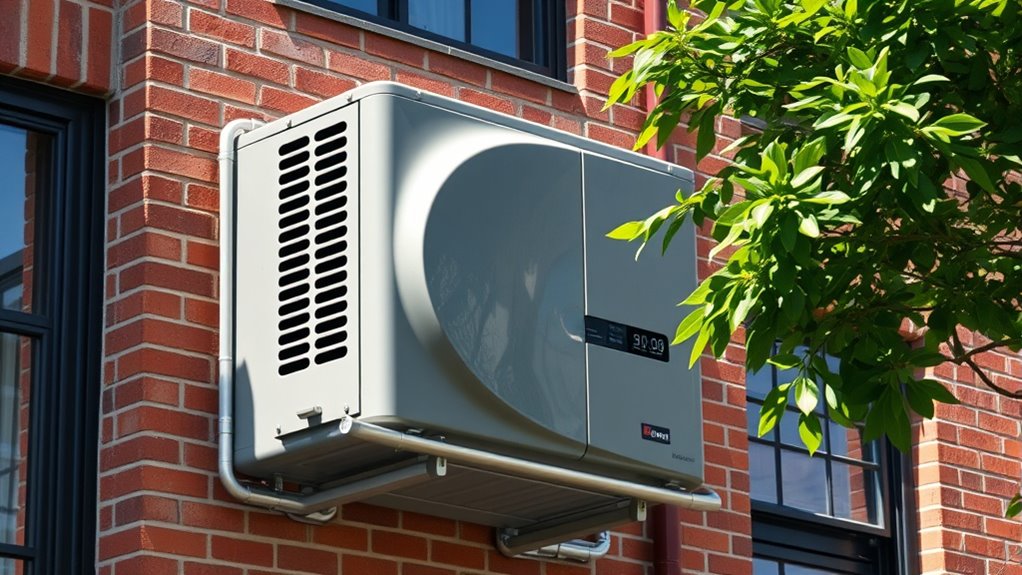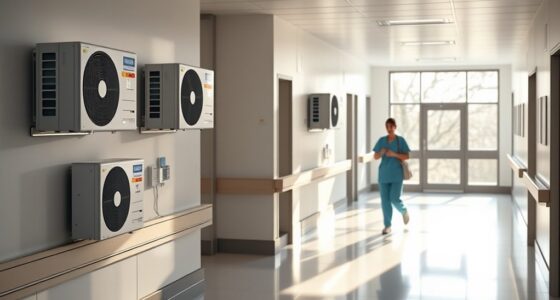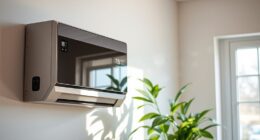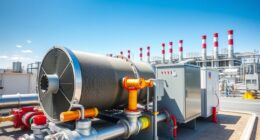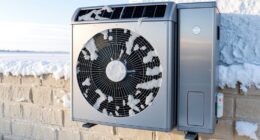Heat pumps are increasingly suitable for multi-unit residential buildings thanks to advancements like cold climate operation, inverter technology, and AI controls. They offer significant energy savings, lower emissions, and support climate goals, especially with policy incentives and rebates. While retrofit challenges exist, solutions like thermal storage and smart controls help overcome them. To understand how these innovative systems can benefit your building and future trends, keep exploring the possibilities.
Key Takeaways
- Heat pumps offer energy-efficient heating and cooling solutions suitable for multi-unit residential buildings, reducing operational costs and emissions.
- Selection depends on climate, building size, and available outdoor or ground space, with advancements improving cold-weather performance.
- Policy incentives like tax credits and rebates support retrofit projects, promoting wider adoption in multi-family housing.
- Challenges include infrastructure constraints and high upfront costs; solutions involve system upgrades, thermal storage, and smart controls.
- Technological innovations, such as inverter technology and AI-driven controls, enhance efficiency, reliability, and integration in multi-unit settings.
Understanding Heat Pump Technology and Types Suitable for Multi-Unit Residences
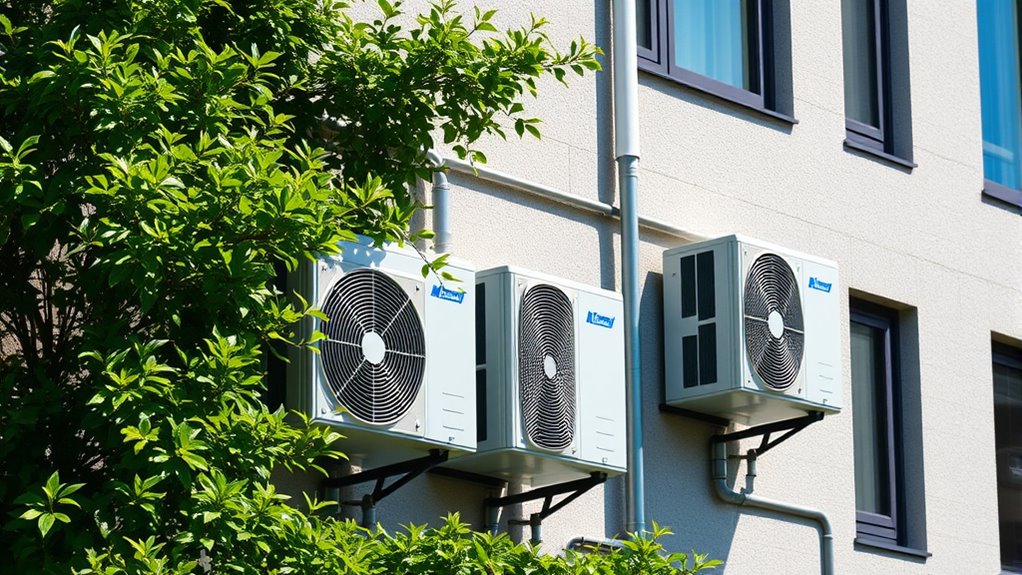
Have you ever wondered how heat pumps can efficiently provide heating and cooling for multi-unit residential buildings? Heat pumps work by transferring heat from outdoor air, ground, or water sources, making them effective for multi-family buildings. The most common type is air-source heat pumps (ASHPs), which are now capable of functioning well in cold climates thanks to technological advances. Ground-source heat pumps (GSHPs) use buried loops to extract heat from the ground, offering high efficiency but with higher installation costs, suitable for new or retrofit projects. Water-source heat pumps (WSHPs) utilize water from central systems or natural bodies, ideal where water infrastructure exists. Selecting the appropriate heat pump type involves considering climate, building size, and available space for outdoor units or ground loops. Understanding heat pump efficiency is crucial for optimizing energy use and cost savings in multi-unit buildings. Additionally, the effectiveness of these systems depends on proper system design and system maintenance, which ensures longevity and optimal performance. Incorporating Alaskan climate considerations can further enhance system reliability and efficiency in cold environments. Properly assessing climate adaptation strategies can help in optimizing system performance across different geographic conditions.
Key Benefits of Implementing Heat Pumps in Multifamily Buildings

Implementing heat pumps in multifamily buildings offers significant energy savings and environmental benefits. They drastically improve energy efficiency, reducing costs by 30-60% compared to traditional systems. By operating with renewable energy, heat pumps support your climate goals with near-zero CO2 emissions. Dual-function models simplify building systems, providing both heating and cooling in one unit. Plus, incentives like rebates and tax credits up to $5 per square foot make adoption more affordable. Modern heat pump technology performs well even in cold climates, expanding their applicability. Proper sizing and installation are crucial for maximizing their benefits and ensuring long-term performance. Familiarity with system operation and maintenance ensures continued efficiency and reliability over time.
Technological Advancements Enhancing Heat Pump Performance
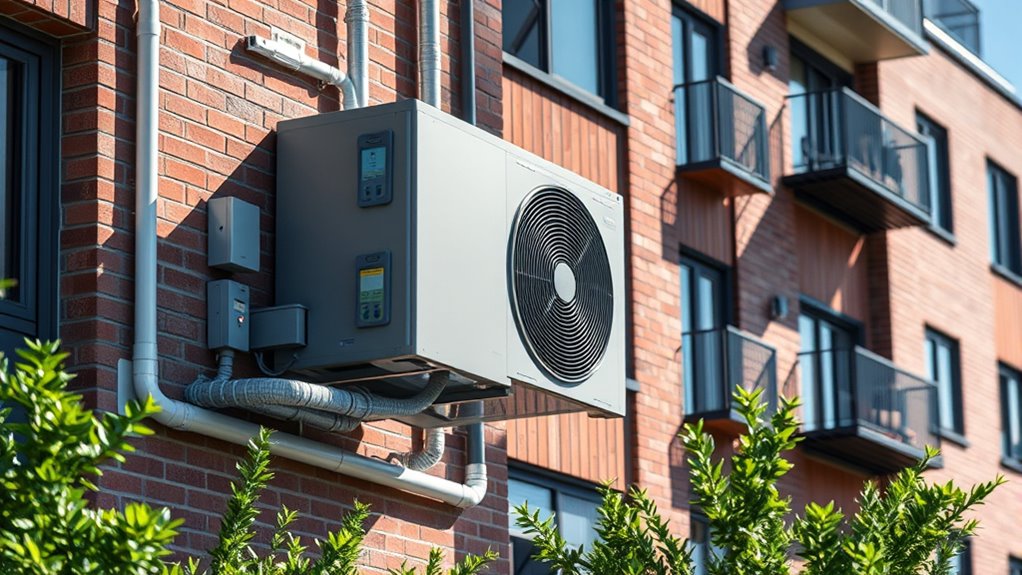
Recent technological innovations are markedly boosting heat pump performance, making them more effective across diverse climates and building types. Cold climate heat pumps now operate efficiently below -15°C, expanding their applicability in colder regions. Inverter technology enhances modulation capabilities, allowing precise adjustments to meet fluctuating heating and cooling demands, which reduces energy use. AI-driven controls optimize performance by analyzing real-time data, detecting faults, and enabling predictive maintenance, ensuring reliable operation. Advances in refrigerant formulations, such as low-GWP options like R-32, improve environmental sustainability without sacrificing thermal performance. Additionally, hybrid systems combining heat pumps with thermal storage and other building systems offer greater operational flexibility and efficiency. Enhanced control systems utilize advanced algorithms to further improve operational stability and responsiveness. Furthermore, ongoing research into refrigerant efficiency aims to develop even more sustainable options that can boost overall system performance. Innovations in system integration facilitate seamless coordination between heat pumps and other building management systems, optimizing energy use. These innovations collectively elevate heat pump capabilities, making them a crucial solution for energy-efficient multi-unit residential buildings, especially as heat pump technology continues to evolve rapidly.
Environmental Impact and Contribution to Decarbonization Goals
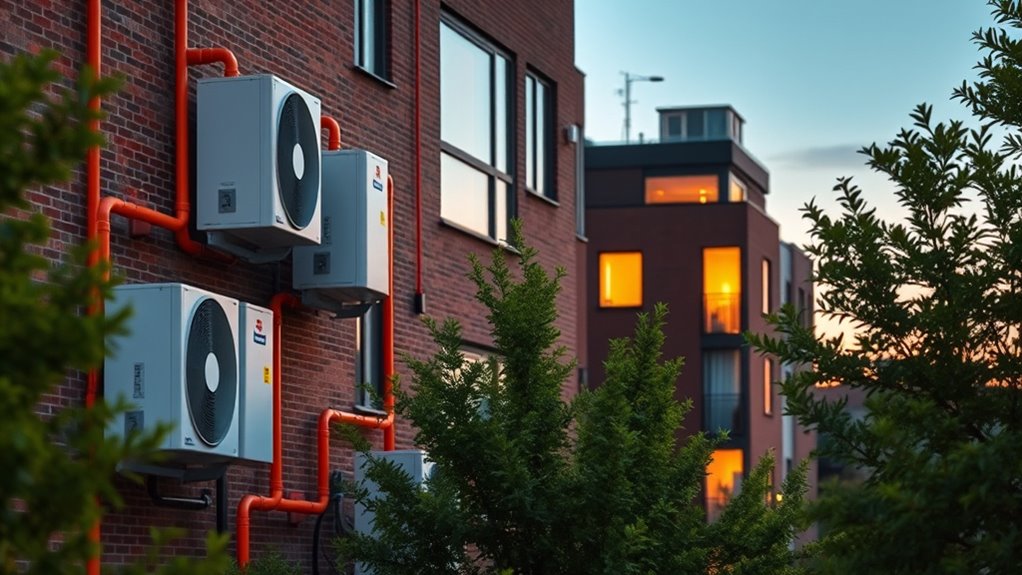
As the world seeks to reduce greenhouse gas emissions, heat pumps play a pivotal role in advancing decarbonization goals, especially in multi-unit residential buildings. By operating with near-zero emissions when powered by renewable energy, they substantially cut your building’s carbon footprint. Replacing fossil fuel systems with heat pumps aligns with climate mitigation efforts and supports net-zero targets. Modern heat pumps deliver high energy efficiency, even in cold climates, further reducing reliance on carbon-intensive heating sources. Solar energy solutions can be integrated to power heat pumps, enhancing their environmental benefits and reducing operational costs. Widespread adoption, backed by policy and incentives, can lower global CO₂ emissions by over 500 million metric tons by 2030. This shift accelerates the transition to sustainable urban environments. Additionally, advancements in heat pump technology continue to improve performance and affordability, making them an increasingly viable solution for diverse building types. Incorporating renewable energy integration strategies can maximize environmental benefits and promote energy independence. Furthermore, the efficiency of hydrogen fuel cells demonstrates their potential to complement renewable energy systems in achieving decarbonization goals.
Emerging AI security solutions can enhance the monitoring and protection of critical energy infrastructure, ensuring reliable operation of decarbonization technologies.
Overcoming Challenges in Deploying Heat Pumps in Multi-Unit Settings

Deploying heat pumps in multi-unit residential buildings faces several challenges that can hinder widespread adoption. First, retrofit challenges can be significant, as existing systems often require extensive upgrades to improve energy efficiency. Second, infrastructure constraints, such as limited outdoor space or heat source access, complicate heat pump deployment in urban multi-family buildings. Third, high upfront costs and the need for capacity upgrades—since many standard heat pumps are below 50 kW—make installation financially formidable. Additionally, many older buildings demand high heating temperatures above 60°C, which standard heat pumps can’t efficiently deliver. Addressing these issues involves performance upgrades to improve efficiency, expanding capacity options, and improving awareness of long-term benefits, to facilitate more effective integration of heat pumps into multi-unit settings. Implementing cost-effective solutions and innovative technologies can also help overcome financial barriers and promote adoption across diverse building types, especially as energy efficiency measures become more accessible. Developing modern heat pump technology that can operate efficiently at higher temperatures is essential for widespread application in older buildings.
Policy Incentives and Financial Support for Adoption

Policy incentives and financial support play a crucial role in making heat pump adoption more accessible for multi-unit residential buildings. Tax credits, like the $5 per square foot incentive from the Inflation Reduction Act, notably lower upfront costs. Utility rebates from local energy providers offer additional financial incentives for upgrading to energy-efficient systems. Government grants and funding opportunities support retrofit projects that replace fossil fuel heating with heat pumps, easing the financial burden for property owners. Building codes increasingly mandate or incentivize renewable heating solutions, further encouraging adoption. Specialized incentive programs and technical support services help property owners and contractors navigate application processes, ensuring they maximize financial benefits. Additionally, active listening and empathy in communication between stakeholders can facilitate smoother implementation of such policies. Recognizing the importance of comprehensive understanding of incentives can further enhance the effectiveness of adoption strategies. For example, understanding the specific support programs available in local areas can help property owners access additional resources. Developing a clear awareness of energy efficiency standards can also aid in aligning projects with regulatory requirements. Moreover, understanding the potential cost savings associated with energy-efficient systems can motivate property owners to proceed with upgrades. These policies collectively create a more favorable environment for integrating heat pumps into multi-unit residential buildings.
Strategies for Successful Integration and Retrofits
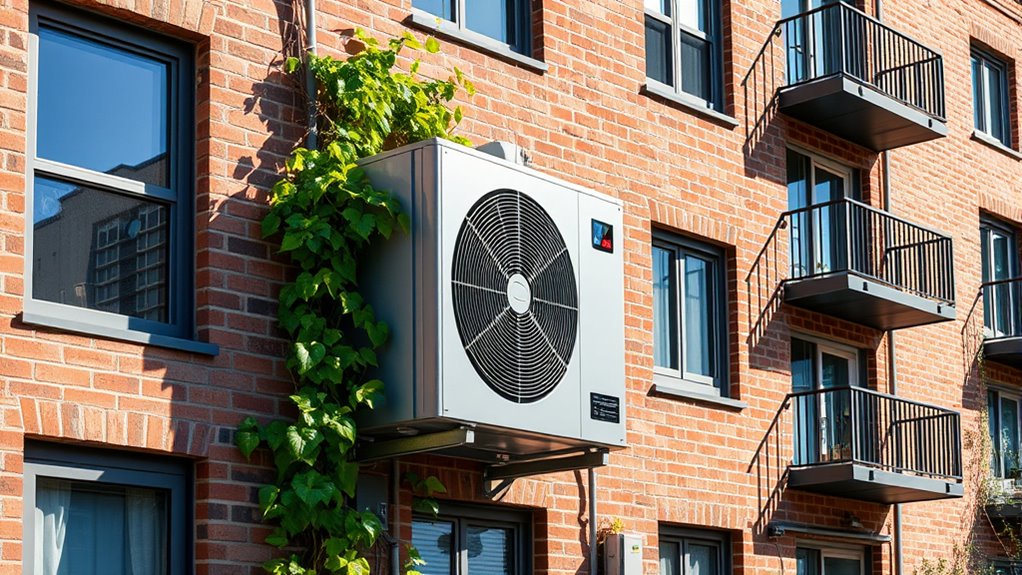
Successful integration of heat pumps into multi-unit residential buildings hinges on careful planning and precise execution. To achieve this, focus on these key retrofit strategies:
- System sizing: Accurately assess the building’s heating and cooling loads to select compatible heat pump types like VRF or multi-split systems, ensuring efficient heat pump integration. Proper sizing prevents issues like short cycling or inadequate heating, which can diminish system performance and longevity. Incorporating high-performance components enhances overall system efficiency and reliability.
- Evaluate existing infrastructure: Inspect and adapt piping, electrical systems, and distribution networks. Reusing or modifying current components minimizes costs and complexity.
- Enhance performance with thermal storage: Incorporate thermal storage and smart controls to optimize operation, reduce peak energy demand, and improve overall system efficiency during retrofits.
- Leverage automation technologies: Integrating automation systems can further enhance system performance, improve energy management, and adapt operation to occupant needs. Utilizing building management systems allows for real-time monitoring and adjustments, maximizing efficiency and occupant comfort.
Engaging stakeholders early and conducting thorough site assessments further guarantee long-term success.
Future Outlook and Market Trends for Multi-Family Heat Pump Systems
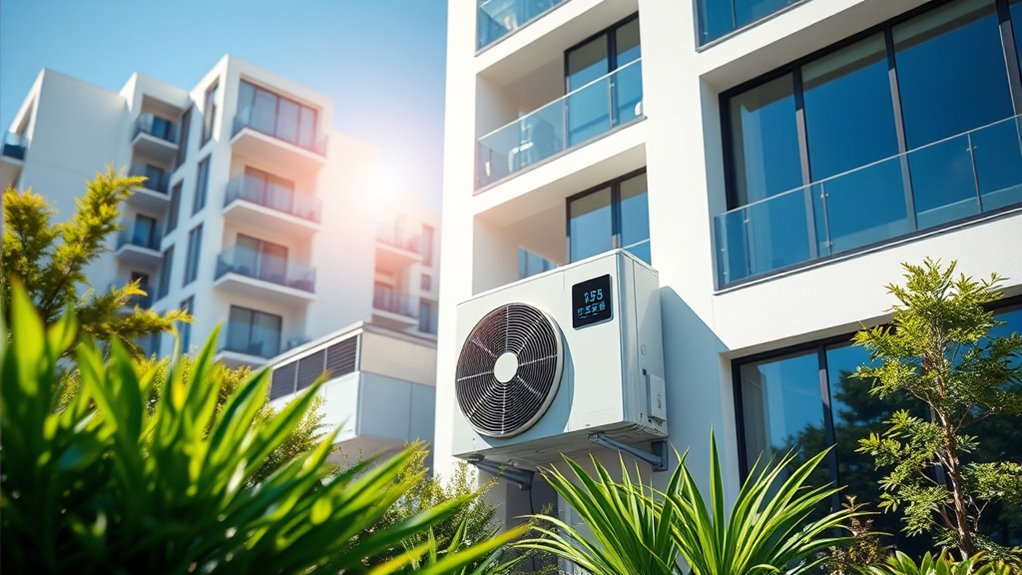
Although the global market share of heat pumps in multi-family buildings remains modest—typically between 1% and 7%—significant growth is expected as policy incentives and electrification initiatives take hold. Market trends indicate that advancements in cold climate heat pump technology are expanding their suitability for diverse climates, boosting adoption in multi-unit residential settings. Technological innovations like AI integration and thermal storage further improve system performance, reliability, and cost-effectiveness. Policy measures such as the Inflation Reduction Act and decarbonization targets are accelerating the shift toward heat pumps in multi-family buildings. By 2030 and beyond, these trends suggest that heat pumps will play a dominant role in improving energy efficiency, with forecasts indicating they could comprise up to 90% of new heating unit sales in the residential sector by 2050.
Frequently Asked Questions
Can Heat Pumps Be Used in Large Buildings?
You wonder if heat pumps can work in large buildings. The answer is yes, they can, but it depends on their capacity and the building’s heating needs. Modern cold climate and ground-source heat pumps are designed to handle big loads efficiently. You’ll need a well-planned system with zoning and distribution, but keep in mind that upfront costs and infrastructure can make deployment challenging.
Why Don’t Contractors Like Heat Pumps?
You might wonder why contractors avoid heat pumps. They often hesitate because they’re unfamiliar with the technology and lack specific training. High upfront costs and uncertain returns make them cautious about recommending them. Technical challenges, like integrating with existing systems or meeting high-temperature needs, also play a role. Plus, limited awareness of incentives and doubts about reliability in extreme climates further discourage contractors from promoting heat pumps.
How Do Heat Pumps Work in Apartment Buildings?
Imagine a magic box that moves warm air from outside to keep your home cozy or cool. That’s how a heat pump works in apartment buildings. You turn it on, and it uses a refrigeration cycle to transfer heat, even in cold weather. It’s efficient and eco-friendly, reducing energy bills, and helps protect the planet. You get comfortable living while doing your part for the environment.
Where Should You Not Put a Heat Pump?
You should avoid placing a heat pump in enclosed or poorly ventilated spaces, as lack of airflow can cause overheating and reduce efficiency. Don’t install it in areas prone to high moisture, like basements or crawl spaces, because this can lead to corrosion. Keep it away from exhaust vents, contaminants, or narrow spaces with limited outdoor access. Also, avoid direct sunlight exposure without shading, which can cause overheating and damage the unit.
Conclusion
By adopting heat pumps in multi-unit buildings, you can substantially cut energy costs and reduce carbon emissions—up to 50% less energy use compared to traditional systems. With advancements making them more efficient and affordable, now’s the perfect time to contemplate retrofitting your property. Embracing this technology not only benefits your bottom line but also helps meet ambitious decarbonization goals, paving the way for a cleaner, more sustainable future for all residents.
